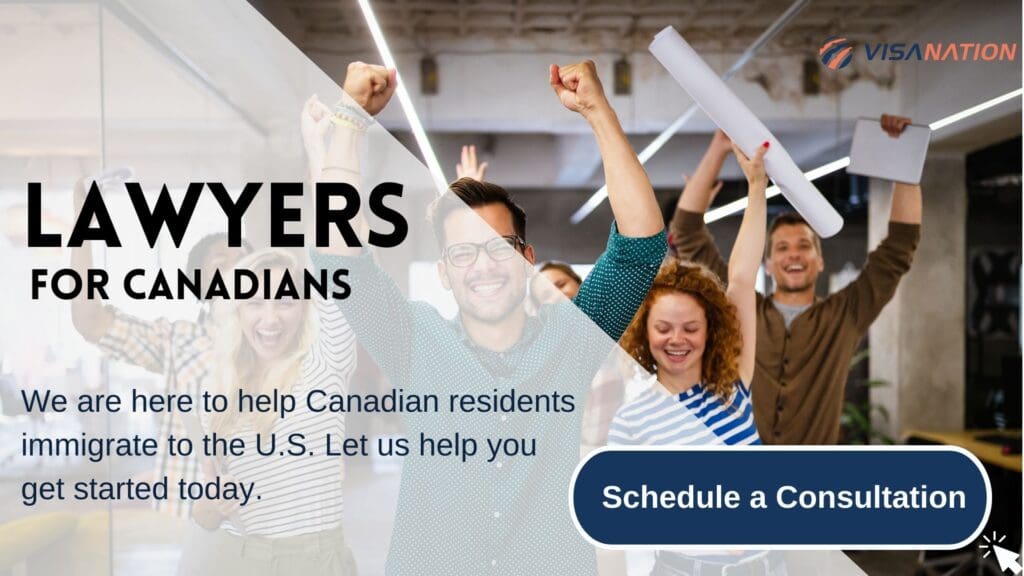How to Move to USA from Canada in 2023: Complete Guide
Dreaming of starting a new chapter in the land of opportunity? Moving to the United States from Canada is an exciting endeavor that opens up a world of possibilities. However, navigating the complex immigration process can be daunting without the right guidance. That’s where our immigration law firm comes in. In this comprehensive guide, we will walk you through the essential steps, requirements, and options for making your move to the U.S. in 2023. Let’s embark on this journey together and turn your American dream into a reality! Our lawyers help to bring numerous Canadians to the U.S. every year. We make the entire process seamless and quick, schedule a consultation, and unlock the full potential of living and working in the U.S.
We make it easy for Canadians to immigrate to the U.S.
Schedule a Consultation
1. Determine Your Eligibility
Before embarking on your immigration journey, it’s crucial to assess your eligibility for entering the U.S. The U.S.immigration system offers various pathways, such as family-sponsored immigration, work visas, investment opportunities, and more. Our experienced immigration attorneys can help evaluate your circumstances and identify the most suitable route for you.
Examples of this step are:
- If you have immediate family members who are U.S. citizens or permanent residents, you may be eligible for family-sponsored immigration.
- If you possess specialized skills or education in a specific field, you might qualify for an employment-based visa such as the H-1B visa.
- If you plan to invest a significant amount of capital in a new commercial enterprise in the U.S., the EB-5 visa could be a suitable option.
2. Choose the Right Visa Category
Once you’ve determined your eligibility, it’s time to select the appropriate visa category that aligns with your goals and qualifications. Whether you’re seeking employment, pursuing education, starting a business, or joining family members already in the U.S., there are specific visas tailored to each situation. Some popular options include the H-1B visa for skilled workers, the F-1 visa for students, the EB-5 visa for investors, and the family-sponsored immigrant visas.
Examples of this step are:
- An aspiring student seeking higher education in the U.S. might consider applying for an F-1 student visa.
- If you are a skilled professional with a job offer from a U.S. employer, the H-1B visa may be appropriate.
- Those looking to start a business in the U.S. and invest a substantial amount of capital could explore the EB-5 investor visa.
3. Gather the Required Documentation
To support your visa application, you will need to gather essential documentation. These may include your passport, birth certificate, educational transcripts, proof of work experience, financial statements, and any other relevant evidence specific to your chosen visa category. Our knowledgeable attorneys can guide you through the document collection process, ensuring you have all the necessary paperwork to strengthen your application.
Examples of this step are:
- A valid passport and birth certificate are essential documents to establish your identity.
- Educational transcripts, diplomas, and language proficiency test scores may be necessary when applying for student visas.
- Letters of recommendation, work experience documentation, and a comprehensive resume might be required for employment-based visas.
4. Submit Your Application
Once you’ve gathered the required documents, it’s time to prepare and submit your application. This step involves completing the necessary forms, paying the applicable fees, and submitting your supporting documentation to the appropriate U.S. government agency. Our immigration law firm can assist you in navigating the complex application process, ensuring accuracy and compliance with all legal requirements.
Examples of this step are:
- Depending on the visa category, you will need to complete the appropriate forms, such as the DS-160 for nonimmigrant visas or the I-485 for permanent residency.
- Pay the required application fees, which vary based on the visa type and processing times.
5. Attend Interviews and Biometrics Appointment
In many cases, applicants are required to attend interviews and provide biometrics as part of the immigration process. These interviews are conducted to assess your eligibility, confirm the information provided in your application, and determine whether you meet the necessary criteria for entry into the U.S. Our attorneys will thoroughly prepare you for these interviews, ensuring you feel confident and ready to present your case.
Examples of this step are:
- As part of the immigration process, you may be required to attend an interview at a U.S. embassy or consulate to provide additional information and answer questions related to your visa application.
- Biometrics, including fingerprinting and a photograph, are typically taken at a designated application support center.
It’s never been easier to move to the U.S. from Canada
Schedule a Consultation
6. Await a Decision
Once your application is submitted and interviews are completed, the U.S. government will review your case and make a decision on your immigration status. The processing times may vary depending on the visa category and other factors. Our dedicated attorneys will monitor the progress of your application, keeping you informed and addressing any concerns that may arise during the waiting period.
Examples of this step are:
- The U.S. government will review your application, conduct background checks, and evaluate your eligibility. The processing times may vary depending on the visa category.
- You will receive a notification of the decision, which can range from approval, denial, or a request for additional documentation or evidence.
7. Plan Your Arrival and Settlement
Congratulations! Once your immigration application is approved, it’s time to plan your arrival and settle into your new life in the U.S. This includes arranging travel, finding housing, familiarizing yourself with the local culture and customs, and addressing any other logistical considerations. Our team can provide guidance and resources to help ensure a smooth transition for you and your family.
Examples of this step are:
- Research and plan your travel arrangements to the U.S., including booking flights and securing temporary accommodations.
- Familiarize yourself with the local culture, customs, and regulations of the city or state where you will be residing.
- Consider practical aspects such as finding long-term housing, opening a bank account, and obtaining health insurance.
8. Post-Immigration Support
At our immigration law firm, our commitment to our clients extends beyond the visa application process. We provide ongoing support and legal counsel to help you navigate the complexities of living and working in the U.S. Our team can assist with matters such as obtaining driver’s licenses, social security numbers, extending or changing visa statuses, and addressing any legal issues that may arise during our time in the U.S. Our experienced attorneys are here to answer your questions, provide guidance on immigration compliance, and help you navigate any legal challenges that may arise.
Examples of this step are:
- Seek legal advice and guidance on maintaining legal status, such as renewing visas or adjusting to permanent residency.
- Understand the rights and responsibilities of immigrants in the U.S., including obtaining a driver’s license, social security number, and understanding tax obligations.
- If faced with any legal issues or challenges during your stay, consult an immigration attorney to ensure proper resolution and compliance with U.S. immigration laws.
Unlock the power of living and working in the U.S.
Schedule a Consultation
Immigration Visa Options for Canadians Moving to the U.S.
For Canadians looking to immigrate to the U.S., there are various immigration options to explore. Here are some key visa categories and examples of visa types within each category:
Family-Sponsored Immigration
Employment-Based Immigration
- H-1B Visa: For individuals with specialized knowledge or advanced degrees who have a job offer from a U.S. employer.
- L-1 Visa: For intracompany transfers, allowing employees of multinational companies to work in a U.S. branch.
- O Visa: For individuals with extraordinary ability in fields such as science, arts, education, athletics, or business.
Investment-Based Immigration
Student Visas
- F-1 Visa: For full-time academic or language study at U.S. colleges, universities, or other educational institutions.
- J-1 Visa: For exchange visitors participating in programs related to education, research, or cultural exchange.
Temporary Work Visas
- TN Visa: Available under the North American Free Trade Agreement (NAFTA) for certain professionals from Canada and Mexico.
- E-1/E-2 Visa: For individuals from countries with treaty agreements with the U.S., engaging in trade or making substantial investments.
Diversity Visa Lottery
- Diversity Visa (DV) Lottery: Provides a limited number of visas through a random selection process for individuals from countries with low rates of immigration to the U.S.
These are just a few examples of visa categories and types available to Canadians. Each visa category has specific requirements and eligibility criteria that need to be met. It is important to consult with an immigration attorney or explore resources provided by the USCIS to gather accurate and up-to-date information regarding the specific visa options and their requirements.
Moving from Canada to the U.S.
Moving to the U.S. from Canada in 2023 is an exciting opportunity to pursue your dreams and create a brighter future. However, the immigration process can be complex and overwhelming. That’s why our immigration law firm is dedicated to guiding you through every step of the way, ensuring a smooth and successful transition.
With our expertise, you can confidently navigate the eligibility requirements, choose the right visa category, gather the necessary documentation, and submit a strong application. Our team of skilled attorneys will advocate for your best interests, providing you with the legal support and guidance you need to achieve your immigration goals.
Don’t let the intricacies of the immigration process deter you from pursuing your dreams. Contact us today to schedule a consultation and embark on your journey to the U.S. Let us be your trusted partner in making your American dream a reality in 2023 and beyond.
Frequently Asked Questions
Below you will find answers to the most common questions about this topic.
Can a Canadian citizen move to the U.S.?
Yes, Canadian citizens can move to the U.S. However, they will need to go through the appropriate immigration process and obtain the necessary visa or immigration status to reside legally in the U.S.
Is it easy to move from Canada to the U.S.?
The ease of moving from Canada to the U.S. depends on various factors, including the specific visa category, individual circumstances, and compliance with immigration laws. While there are established immigration pathways, the process can be complex and requires careful preparation, documentation, and adherence to legal requirements. Working with an experienced immigration attorney can help simplify the process and ensure a smoother transition.
What is the cheapest way to move from Canada to the U.S.?
The cost of moving from Canada to the U.S. can vary depending on several factors, including the mode of transportation, the distance, and personal preferences. Generally, the cheapest way to move would be to use land transportation, such as driving or taking a bus, as it eliminates the need for airfare or shipping fees. However, it’s important to consider other costs, such as accommodations, meals, and potential border crossing fees, when planning the move.
What do you need to do to move from Canada to the U.S.?
To move from Canada to the U.S., you will typically need to:
- Determine your eligibility for immigration based on the purpose of your move (employment, family sponsorship, etc.).
- Choose the appropriate visa category that aligns with your goals and qualifications.
- Gather the required documentation, which may include passports, birth certificates, educational transcripts, work experience proof, and other supporting materials.
- Submit the visa application to the relevant U.S. government agency.
- Attend any interviews and appointments as required.
- Await a decision on your application.
- Plan your arrival and settlement in the U.S., including travel arrangements, housing, and other logistics.
Working with an immigration attorney can help ensure that you fulfill all the necessary requirements and navigate the process successfully.
What happens if a Canadian stays in the U.S. longer than 6 months?
If a Canadian citizen stays in the U.S. longer than the permitted duration specified by their visa or visa waiver program (typically 6 months for visitors), they may be considered to have overstayed their authorized period of stay. Overstaying can have serious consequences, including being barred from reentering the U.S. for a certain period, denial of future visa applications, and even potential deportation. It is important to comply with the terms of your visa and seek appropriate extensions if needed.
How long can you stay out of Canada if you are a Canadian citizen?
As a Canadian citizen, you can stay out of Canada for as long as you want without losing your citizenship status. Canadian citizenship does not expire, and you can retain your citizenship even if you spend extended periods outside of Canada.







